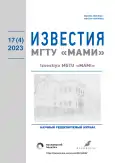Assessment of influence of considering the flexibility of the front loader frame on the emerging loads in the multibody system
- Authors: Rubanov P.S.1, Goncharov R.B.1, Skotnikov G.I.1, Gorelov V.A.1, Grigoriev V.S.2
-
Affiliations:
- Bauman Moscow State Technical University
- Chuvash State Agrarian University named after I.N. Ulyanov
- Issue: Vol 17, No 4 (2023)
- Pages: 401-409
- Section: Transport and transport-technological facilities
- URL: https://journals.rcsi.science/2074-0530/article/view/252146
- DOI: https://doi.org/10.17816/2074-0530-472077
- ID: 252146
Cite item
Full Text
Abstract
BACKGROUND: Dynamic models are widely used for vehicle dynamics simulation. Increase of simulation accuracy is achieved with adding flexible bodies in a model, making problem solving more complicated. Therefore, assessment of influence of considering the flexibility of the front loader frame on the emerging loads in the multibody system becomes necessary.
AIM: Assessment of considering the flexibility of the front loader frame on the emerging loads in the multibody system becomes necessary.
METHODS: The solution of the problem is presented with the example of a multibody model of a 14.5-ton front loader (FL) with a frame coupled with wheel movers rigidly fixed to the front half-frame and a swinging axle at the rear half-frame. This method of coupling makes it possible to assess the effect of the flexibility of the elements of the FL by comparing the vertical forces that occur in the contact patch of the wheels with the support surface. The multibody models are built in the NX Motion application of the NX 2206 software package.
RESULTS: The comparison of vertical wheel forces in given load conditions (symmetrical and skew-symmetric) using absolutely rigid and flexible models of the frame is carried out. It is found that the forces for skew-symmetric loading modes can differ by up to 20% depending on the frame stiffness.
CONCLUSION: As a result of the conducted research, it can be stated that taking into account the suppleness of the load-bearing system of the vehicle significantly affects the results obtained in the process of modeling.
Full Text
##article.viewOnOriginalSite##About the authors
Pavel S. Rubanov
Bauman Moscow State Technical University
Author for correspondence.
Email: rubanov_ps@bk.ru
ORCID iD: 0009-0000-2055-2046
student of the Wheeled Vehicles Department
Russian Federation, MoscowRoman B. Goncharov
Bauman Moscow State Technical University
Email: goncharov.roman@bmstu.ru
ORCID iD: 0000-0003-4805-967X
SPIN-code: 1180-9530
Scopus Author ID: 816252
Cand. Sci. (Tech.), Associate Professor of the of the Wheeled Vehicles Department
Russian Federation, MoscowGleb I. Skotnikov
Bauman Moscow State Technical University
Email: skotnikovg@bmstu.ru
ORCID iD: 0000-0003-3162-5356
SPIN-code: 5025-1660
Cand. Sci. (Tech.), Assistant of the Wheeled Vehicles Department
Russian Federation, MoscowVasily A. Gorelov
Bauman Moscow State Technical University
Email: gorelov_va@bmstu.ru
ORCID iD: 0000-0002-2171-6302
SPIN-code: 1455-9984
Professor, Dr Sci. (Tech.), Head of the Multipurpose Tracked Vehicles and Mobile Robots Department
Russian Federation, MoscowVladimir S. Grigoriev
Chuvash State Agrarian University named after I.N. Ulyanov
Email: wsgrig@chuvsu.ru
ORCID iD: 0000-0003-3437-9541
SPIN-code: 4989-7923
Head of Cheboksary Engineering Center of Transport and Agricultural Engineering
Russian Federation, CheboksaryReferences
- Gorelov VA, Padalkin BV, Chudakov OI. Mathematical model of rectilinear motion along a deformable supporting surface of a two-link semi-trailer road train with an active semi-trailer link. Vestnik MGTU im. N.E. Baumana. Seriya: Mashinostroenie. 2017;2(113):121–138. (In Russ).
- Chudakov OI, Ankinovich GG, Gorelov VA. Mathematical model of rectilinear dynamics on a non-deformable support base of a semi-trailer road train with an active semi-trailer. Vestnik mashinostroeniya. 2017;3:37–42. (In Russ).
- Vdovin DS, Chichekin IV, Levenkov YaYu. Prediction of fatigue life of semi-trailer suspension elements at early design stages. Trudy NAMI. 2019;2:14–23. (In Russ).
- Gorelov VA, Komissarov AI, Vdovin DS, et al. Analysis of truck frame loads using the method of dynamics of body systems using a finite element model. Transportnye sistemy. 2020;4(18):4–14. (In Russ). doi: 10.46960/62045_2020_4_4
- Zhu SH, Xiao ZJ, Li XY. Vehicle frame fatigue life prediction based on finite element and multi-body dynamic. Applied Mechanics and Materials. 2012;141:578–585.
- Yudakov AA. Principles for constructing general equations for the dynamics of elastic bodies based on the Craig–Bampton model and their practically significant approximations. Vestnik Udmurtskogo universiteta. Matematika. Mekhanika. Kompyuternye nauki. 2012;3:126–140. (In Russ). doi: 10.20537/vm120312
- Goncharov R.B., Ryabov D.M. Methods of calculating suspension guide elements loads of vehicle when obstacle crossing. Izvestiya MGTU MAMI. 2015;9(3–1):129–135. (In Russ). doi: 10.17816/2074-0530-67249
- Levenkov YaYu, Volskaya NS. Smoothing ability of a pneumatic tire of a car wheel when interacting with a hard, uneven supporting surface. Tekhnologiya kolesnykh i gusenichnykh mashin. 2015;1: 20–26. (In Russ).
- Volskaya NS, Levenkov YaYu, Rusanov OA. Modeling of a car pneumatic tire interacting with a hard, uneven supporting surface. Nauka i obrazovanie. 2013;5:107–124. (In Russ). doi: 10.7463/0513.0571409
- Farid ML. Fundamentals of multibody dynamics: theory and applications. Basel: Birkhäuser; 2006.
- Kong YS, Abdullah S, Omar MZ, et al. Side force analysis of suspension strut under various load cases. Jurnal Teknologi. 2016;78(6):85–90. doi: 10.11113/jt.v78.9193
- Bremer H. Elastic Multibody Dynamics. Berlin: Springer Science+Business Media; 2008.
Supplementary files













